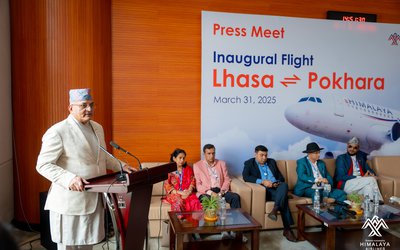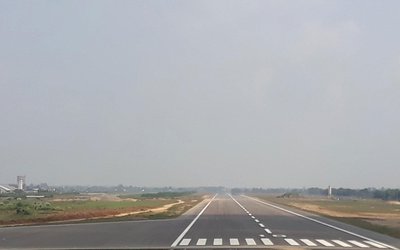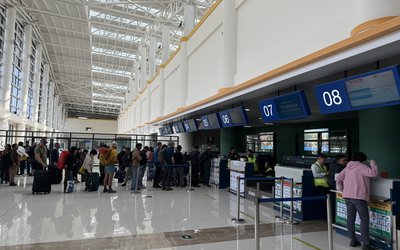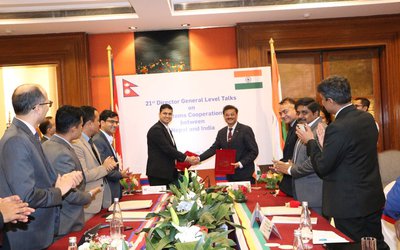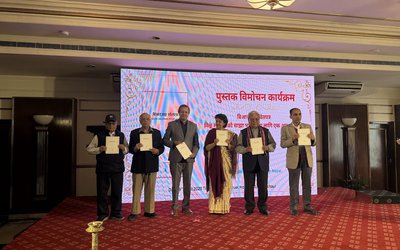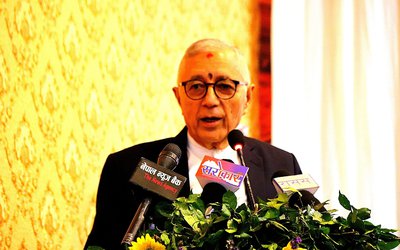
Nepal is a heaven on Earth witnessing occasional throes of manmade and natural disasters. Known as the 'Land of Everest' and a Hindu country in the world, Nepal offers a spectacular scenery, dotted with some of the world’s best and archeologically significant temples here and best walking trails there. It borders with China on the north and India in the South, living like a pearl in an oyster, with a history, excellence, culture and legacy that add to the country's grandeur.One of the worst natural disasters struck Nepal on Saturday, April 25, 2015. A massive 7.8 magnitude tremor was the worst earthquake to strike the region in over 80 years. A second 7.3 magnitude quake hit it again just 17 days later, on May 12, causing further damage and suffering for those who had survived the initial disaster.
Although two years have already passed since those dreadful days, an overwhelming number of temples and heritage sites are yet to be rebuilt, according to a recent report released by National Reconstruction Authority.
The earthquake had damaged 750 heritage sites, 133 of them completely and 617 partially, according to Yam Lal Bhoosal, Joint Secretary at the National Reconstruction Authority.
Currently 90 heritage sites are under reconstruction. Those include 28 in Patan Durbar Square, 12 in Basantapur Durbar Square, 19 in Bhaktapur Durbar Squre, 4 in Swayambhu Durbar Square, 21 in Pashupatinath Temple area, and 5 in Changu Narayan area. However, work on only one heritage site Bauddhanath Stupa has been completed.
Although Germany, Japan, India, the United States of America and China are providing financial support for reconstruction, the pace is said to be too slow.
"Heritage reconstruction is a very slow process as you cannot build it overnight,” said Bhesh Raj Dahal, Director General of Department of Archeology. “The reconstruction of heritage sites will take pace gradually. All the development partners have already started the work.”
Disastrous events, in politically paralyzed nations including Nepal, often come in a chain of events, with one disaster feeding into the other for years or even decades at its end. The aftereffects from the earthquake have subsequent results on the myriad of seemingly unrelated factors: human trafficking, labor fee and availability, rental and property cost burdens, urbanization, private and public debt burdens, mental health, politics, tourism, disease, major damage to the healthcare system and what not.
The earthquake, which occurred right in the middle of Nepal’s spring trekking season, brought the season to an abrupt halt. Nepal’s key tourism products including UNESCO world heritage sites: Kathmandu Durbar Square, Patan Durbar Square, Bhaktapur Durbar Square, Swayambhu Nath and Boudha Nath suffered a major damage. An attempt is made to recount their values here.
Kathmandu Durbar Square:
The main point of tourist attraction and Kathmandu's heritage is its old historic royal square known as Basantapur or more popularly by tourists as Kathmandu Durbar Square. Located in the heart of the ancient city of Kathmandu, I know I saw it as part of a complex of beautiful temples and shrines, both Hindu and Buddhist. Most of them are built in the Pagoda style, embellished with intricately carved exteriors, built between 12th and 18th centuries. It was also home to Kasthamandap, Kathmandu’s first building dating back to the Licchavi period in the third century, which was raised to the ground after the 2015 earthquake. The earthquake shook the Durbar Square to its knees and tore down most of the southern section of temples and sent cracks of destruction throughout the other buildings. Some of the buildings which were completely destroyed are Trailokya Mohan, Chasin Dega, Maju Dega, Narayan Vishnu and Kakeshwar temples. Most of the remaining buildings have been shored up with wooden pilings to provide maximum support, stability and to prevent further damage.
Patan Durbar Square:
Once a fiercely independent city-state, Patan is now almost a suburb of Kathmandu, separated only by the murky Bagmati River. Many locals still call the city by its original Sanskrit name of Lalitpur (City of Beauty) or by its Newari name, Yala. Patan is the best known for its artistic heritage, it is also probably one of the oldest Buddhist Cities in the world. The city is surrounded by four Stupas as four corners of Patan, one at each corner of its cardinal points. These stupas are said to have been built by the famous Emperor Ashoka. The Patan Durbar Square is full of ancient and historical places, temples, and shrines noted for their exquisite carvings.
The former royal palace complex is the centre of Patan's religious and social life and houses a museum containing an array of bronze statues and religious objects. At Patan Durbar Square, two temples Char Narayan (the oldest temple of the Square) and Hari Shankar along with two paatis were destroyed, while many other temples were weakened like the Vishwanath Temple and the Bhimsen Mandir.
Bhaktapur Durbar Square:
"Were there nothing else in Nepal, save the Durbar Square of Bhaktapur, it would still be amply worth making a journey half way round the globe to see." - E.A Powell (The last home of Mystery) 1929, London
Bhaktapur is known as Khwopa in the local Newari tongue. The cultural capital of Nepal, Bhaktapur's history goes back to the early 8th century and it used to be the capital city of the Kingdom of Nepal till the 15th century. A blend of northern art and southern mythological philosophy, the aged arts, architecture, and culture are the heritage of Bhaktapur that it inherits from the earlier generations. The Pagoda and Shikara styled temples, Vihars and Bahis (traditional Buddhist monasteries), Lonha Hiti, ponds, math, sattal (public shelters), stupas, city gates, terracotta temples, and other cultural and historical heritages are the major monuments of the ancient city. The third of the medieval city-states in the Kathmandu Valley, Bhaktapur was always described as the best preserved. Tragically, the 2015 earthquake caused terrible destruction, with whole streets of historical houses lost to the disaster. Only a few temples were destroyed but many traditional buildings that survived the earthquake have since been declared uninhabitable and are now being torn down. The scars of the disaster are still clearly visible and it will take years for the city to fully recover. 80% of the temples around its Durbar Square are destroyed, including the 18th-century Vatsala Durga temple, Khauma Dwaar the entrance gate to the Durbar Square, and other buildings. According to Bhaktapur Municipality, the total number of buildings destroyed were 172 temples, 37 sattals, 256 paties, 88 stone spouts, 252 wells, 36 ponds, 29 monasteries, and 116 other heritage monuments.
Swayambhunath:
Swayambhunath is one of the holiest Buddhist Chaityas in Nepal. It is said to have evolved spontaneously when the valley was created out of a primordial lake more than 2,000 years ago. This Stupa is the oldest in Nepal and has numerous shrines and monasteries on its premises. Legend has it that Swayambhu was born out of a lotus flower that bloomed in the middle of a lake that once spread across the Kathmandu Valley. The largest reflection of the Sakyamuni Buddha in Nepal sits on a pedestal on the western corner of Swayambhu. Behind the hilltop is a temple dedicated to Manjushree or Saraswati - the Goddess of learning. Most of Swayambhunath’s structures suffered significant damage in the 2015 earthquake. The Anantapura shikhara to the left of the steps toppled and there was serious damage to buildings on the west side of the Swayambhunath.
Boudhanath:
The first stupa at Bodhnath was built sometime after AD 600, when the Tibetan king, Songtsen Gampo, converted to Buddhism. In terms of grace and purity of line, no other stupa in Nepal comes close to Bodhnath. From its pure white dome to its gilded tower painted with the all-seeing eyes of Lord Buddha, the monument is perfectly proportioned. According to legend, the king constructed the stupa as an act of penance after unwittingly killing his father. The first stupa was destroyed by Mughal invaders in the 14th century, so the current stupa is a newer construction. The 13 levels of the spire represent the stages that a human being must pass through to achieve nirvana. The 2015 earthquake badly damaged Boudhanath Stupa, severely cracking the spire. As a result, the whole structure above the dome, and the religious relics it contained had to be removed.
Raja Shrestha, a government authorized guide who works at the Kathmandu Durbar Square says, "We did receive a lot of help from foreigners and welfare workers who personally came down all the way to Nepal to help us out. With time we recovered, but the tourists were convinced about the safety in the country due to the fact that many media organizations continued to show only the negative side of the earthquake. This made them believe that Nepal was in a much worse condition that before."
Despite all the difficulties, Nepal has persevered in its view to have a bright future. Last year saw 753,000 tourists return to the country – only 37,000 fewer than the year before the quake. The aftermath of the biggest natural disaster to hit Nepal in more than 80 years may be visible for many years to come, but for travelers, there still remains an abundance of cultural and natural treasures to enjoy. Rest assured, Nepal today is surely in better hands. Though many of the sites need reconstruction and repairs, nothing can stop it from being what it once was, an epitome of prosperity and perfection.
(Rushith Reddy is an intern from Bangalore, India)




AG Rushith
AG Rushith is an intern from Bangalore
- An Indian Tourist's Day In Kathmandu
- Jun 05, 2017
